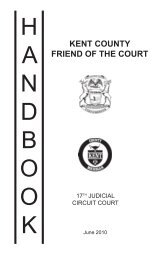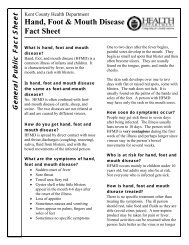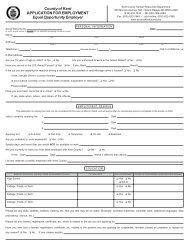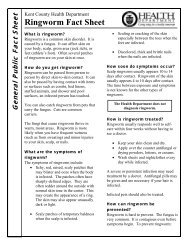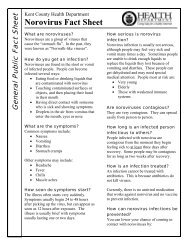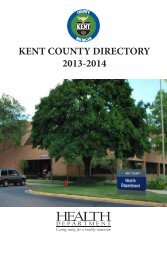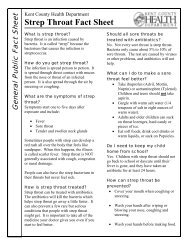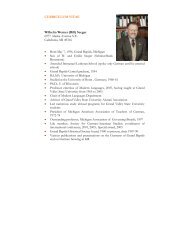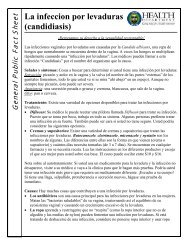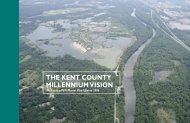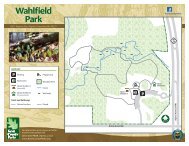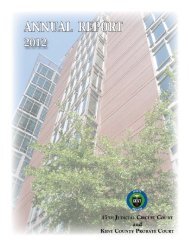How Federal Subsidies Encourage Wasteful Local Transit Systems
How Federal Subsidies Encourage Wasteful Local Transit Systems
How Federal Subsidies Encourage Wasteful Local Transit Systems
Create successful ePaper yourself
Turn your PDF publications into a flip-book with our unique Google optimized e-Paper software.
No. 559 January 5, 2006RoutingA Desire Named Streetcar<strong>How</strong> <strong>Federal</strong> <strong>Subsidies</strong> <strong>Encourage</strong> <strong>Wasteful</strong><strong>Local</strong> <strong>Transit</strong> <strong>Systems</strong>by Randal O’TooleExecutive SummaryThe nation’s mass transit system is a classicexample of how special interests prevail over theneeds and interests of voters and taxpayers. Totalinflation-adjusted subsidies to transit—busesand trains—have more than doubled since 1990,yet total ridership has increased by less than 10percent. Train ridership has dropped dramaticallywhile automobile use has skyrocketed.Prior to 1964, when Congress began subsidizingtransit, the industry was mostly private.Since then, the industry has been almost entirelytaken over by state and local governments. Todaymore than three of every four dollars spent ontransit come from taxpayers, not transit riders.The effectiveness of local transit systems isundermined by federal subsidies, which encouragethe construction of highly visible and expensive servicessuch as light-rail trains to suburban areasdespite the chronically low number of riders onthose routes. <strong>Federal</strong> subsidies to transit advocacygroups and misguided environmental and laborregulations also encourage a large investment oftaxpayer money in wasteful transit systems.The ideal solution would be to devolve transitand other transportation funding entirely to stateand local governments. Short of that, Congressshould reform the federal transportation fundingsystem to minimize the adverse incentives it creates._____________________________________________________________________________________________________Randal O’Toole is director of the Thoreau Institute and an adjunct scholar at the Cato Institute.
The federalgovernment hassucceeded increating a systemthat promoteswildly extravagantspending on trainsystems.IntroductionThe nation’s transit system is a classicexample of how special interests prevail overthe needs and interests of voters and taxpayers.Total inflation-adjusted subsidies totransit—local buses and trains—have morethan doubled since 1990, yet transit ridershiphas increased by less than 10 percent. Theresult is that the average cost to taxpayers forevery transit trip has increased by 95 percent,from $1.68 to $3.28 in 2003 dollars.Prior to 1964, when Congress began subsidizingtransit, the industry was mostly private,and, though it was losing riders, it operatedat an overall profit. Since then, theindustry has been almost entirely taken overby state and local governments. Today morethan three of every four dollars spent on transitcome from taxpayers, not transit riders.The reason localities continue to fundtrain systems that are surprisingly underused,expensive, and wasteful can be traced directlyto federal subsidies for transit. Since masstransit agencies depend on taxpayers ratherthan users for most of their revenue, theyfocus on highly visible and expensive servicessuch as light-rail transit to suburban areas.The transit industry’s core market consists ofpeople who don’t drive and who mostly live ininner cities. To pay for high-cost suburban railtransit routes, transit agencies often raisefares or cut back on services to inner-cityareas. The result is that taxpayers often endup paying heavy subsidies for projects thatreduce overall transit ridership and oftenharm transit-dependent families.In addition to the huge subsidies offered byCongress to transit agencies, specific incentivesin federal law encourage agencies to wastemoney and exacerbate the problem. Instead ofhelping localities solve real transportationproblems, federal subsidies encourage redirectingtaxpayer money to projects that arelikely to fail.The net result is that the federal governmenthas succeeded in creating a system thatpromotes wildly extravagant spending ontrain systems. The desires of train supportersend up trumping the demands of everyoneelse.The ideal solution would be to end federaltransit subsidies and devolve transit andother transportation funding entirely tostate and local governments by letting themkeep their fuel tax dollars. Short of that,Congress should reform the federal transportationfunding system to minimize theadverse incentives it creates.A Brief History of <strong>Transit</strong>America’s transit industry traces its rootsto 1827 with the first urban coach line inNew York City. 1 The development of steamtrains and horse cars in the 1830s reducedcosts and made transit available to more people.By 1880 American cities had 10,000 milesof horse-car rail lines. 2 In 1871 private entrepreneursbuilt the New York elevated train,which carried masses of people on short tripsfor a nickel each. New York also saw the firstcable car in 1868 and the first subway in1870. 3Outside major cities, transit boomed onlyafter electric streetcars were fully developedaround 1890. Streetcars had such tremendouscost advantages over other forms ofurban transportation that, by 1910, almostevery American city with more than 10,000people had one or more streetcar lines, nearlyall of which were built with private funds.Many streetcar lines were built to connectsuburban real estate developments withdowntown job centers, and transit fares paidthe operating costs. The capital costs werecovered by the sale of homes and lots. Thoselines were later merged into regional transitcompanies.In 1907, the earliest year for which numbersare available, transit companies carriedpassengers on about 9.5 billion trips. By 1926that number had nearly doubled to 17.3 billiontrips, a number that would be exceededonly during and after World War II. Per capitatransit ridership peaked in 1920 at about287 annual rides per urban resident. 42
The rise of the automobile signaled theend of the nation’s streetcar systems. By 1929more than half of all American householdsowned an automobile. State and local governmentsbegan to apply gasoline taxes andother user fees to the paving of streets andhighways throughout urban areas. When thetime came to replace rails, trolley wires, andother capital equipment, transit companiesrealized it made more sense to run buses onpaved streets whose cost was shared withautos than to maintain exclusive rail rightsof-wayand infrastructure for streetcars.Buses were also more flexible and faster thanstreetcars. <strong>Transit</strong> riders annoyed with dilapidatedstreetcars welcomed the newer andmore comfortable buses.Some supporters of mass transit have perpetuatedthe story that General Motors conspiredto destroy the nation’s transit systemsby replacing “efficient” streetcars with “dirty”buses, but that is little more than an urban legendthat has been debunked by numerousbooks and articles. 5 General Motors did purchasean interest in various transit companies,but its only goal was to sell its brand of busesto companies that were already convertingfrom streetcars to buses. The simplest evidenceof this is that General Motors never controlledmore than a small fraction of the nation’s transitlines, and it controlled none after 1949. Yettransit companies in many cities not controlledby General Motors, including Dallas,Denver, Indianapolis, Minneapolis, Portland,and Seattle, all converted from streetcars tobuses, mostly during the 1950s.The shift to buses was mainly prompted bythe inefficiencies of streetcars, which were apparentto both public officials and private transitoperators. In 1955, for example, Congressordered the company operating streetcars inWashington, D.C., to convert its system to buseswithin eight years. 6 The last Los Angeles “red car”lines, which were featured as victims of a conspiracyin the movie Who Framed Roger Rabbit?had never been owned by General Motors andwere actually converted to buses by a publicagency, the Los Angeles Metropolitan <strong>Transit</strong>Authority, in 1961. 7In 1966 St. Louis converted its last streetcarline to buses. That left streetcar systems in onlysix American cities—Boston, Philadelphia, SanFrancisco, Pittsburgh, New Orleans, and Cleveland—plusother forms of rail transit in NewYork and Chicago. Private transit companiesand public transit agencies in most other citiesconsidered rail transit economically inviable.Rail systems simply worked better in high-densityurban centers than in less populated cities.Whether by rail or by bus, World War IIboosted transit ridership to a high of nearly23.5 billion trips in 1946, or about 267 tripsper urban resident. The end of wartime fuelrationing led ridership to decline after thatyear by an average of 7 to 8 percent per yearthrough most of the 1950s and by about 3 percentper year in the early 1960s. By 1964 annuabout62 trips per urban resident. 8 Althoughal ridership had fallen to 8.3 billion trips, ortaxpayers supported city-owned transit agenciesin New York, San Francisco, and severalother large cities, 95 percent of the transitindustry remained privately owned. 9<strong>Federal</strong> Intervention in<strong>Local</strong> <strong>Transit</strong> <strong>Systems</strong>In 1964 Congress passed the Urban MassTransportation Act, which promised federalcapital grants to state and local public transitagencies. The law offered capital grants for upto 50 percent of the cost of transit improvements.The law did not provide funds for publicpurchase of private transit companies, butas transportation historian George Smerkobserves, most transit companies, recognizingthe declining nature of their business, “wereanxious to sell out to the public sector.” 10 Socities without government-run transit systemsbought the companies to make themselves eligiblefor the federal grants.Congress has justified many other federaltransportation programs using a liberalinterpretation of the Interstate CommerceClause of the Constitution. But most transitsystems do not cross state lines, so federalsupport for transit is based instead on theAlthoughtaxpayerssupported cityownedtransitagencies inNew York, SanFrancisco, andseveral otherlarge cities, 95percent of thetransit industryremainedprivately ownedin 1964.3
<strong>Transit</strong> growthhas not kept upwith the growthin driving.During the periodwhen transit grewby 46 percent,driving in urbanareas increased bymore than 170percent.General Welfare Clause. 11 <strong>Transit</strong> supportersargue that federal funding for highways,which comes exclusively from highway users,helps people who drive, but many peopledon’t drive or cannot afford to own an automobile.<strong>Subsidies</strong> are needed, they argue, tosupport such transit-dependent people. 12 Infact, the real pressure for federal transit fundingcame from a few large cities that hadrelied on commuter trains to bring workersinto the downtown areas—namely, Boston,Chicago, New York, and Philadelphia.“Downtown areas were not designed tohandle the traffic load which results from . . .reliance upon the private automobile,” argueda 1960 Department of Commerce report. 13The loss of commuter rail service would meanthe death, or at least the shrinkage, of thosedowntowns as jobs followed people to the suburbs.Nationwide, such a transition had beentaking place for more than 50 years. But bigcitymayors and downtown property ownerswielded enormous political influence, andthey reacted with horror to the possible loss ofcommuter trains. Since they blamed that losson Congress, it was natural for them to pressureCongress to rectify the problem.The Kennedy administration offeredintellectual justification for federal interventionin mass transit in 1962. Since most peoplelived in urban areas, “our national welfarerequires the provision of good urban transportation.”To “promote economic efficiencyand livability,” cities needed “the properlybalanced use of private vehicles and modernmass transportation to help shape as well asserve urban growth.” 14In other words, not only should the governmentsubsidize transit to urban centers,such as Manhattan, that were too dense tomake automobile use practical; it should also“shape” other urban areas so that they toocould be served by transit, possibly becomingso dense that they would eventually be inaccessibleto autos. Although that would supposedlybe done for “efficiency” and “balance,”those two goals would soon be derailed in thecause of supporting transit at any cost.Although the notion that transit investmentscan shape urban areas has since proven futile,it remains a major intellectual justification forspending money on mass transit, particularlyrail systems.Soon after the 1964 legislation, whenalmost every private transit company had beenbought by government transit agencies, governmentsat the federal, state, and local levelsbegan to pour billions of dollars of annualsubsidies into transit programs. Yet ridershipcontinued to decline, with drops of 6 percentper year between 1969 and 1972. The industrywas saved only by the gasoline shortages of themid-1970s, which led to sustained ridershipgrowth for the first time since 1946. 15Since 1972 ridership has grown by 46 percentfrom a low of 6.6 billion trips to a 2004level of 9.6 billion trips. <strong>How</strong>ever, that representsno gain in per capita ridership, whichsince 1970 has hovered around 40 to 50 tripsper urban resident and was at the low end ofthat range in 2004. 16 <strong>Transit</strong> growth has notkept up with the growth in driving. Duringthe period when transit grew by 46 percent,driving in urban areas increased by morethan 170 percent. 17 Growth in the ridershipof mass transit is also heavily influenced byexternal factors: ridership increases whengasoline prices are up or the economy booms,and ridership stagnates or falls when gasolineprices fall or the economy is in recession.While federal transit funding was originallyproposed to support commuter trains inNew York, Chicago, Boston, and Philadelphia,the opportunity to gain federal funds inspiredmany smaller urban areas to begin transit service.Today, nearly three-fourths of the 430U.S. urban areas of 50,000 people or more areserved by one or more federally supportedtransit agencies. 18 Yet the vast majority of transitriders are still in the major urban areas. TheNew York urban area alone accounts for threeof eight transit trips, while six areas together—Boston, Chicago, New York, Philadelphia, SanFrancisco, and Washington—account formore than three of five transit trips. 19Were it not for the Urban Mass TransportationAct of 1964, it is conceivable that thegasoline shortages of the 1970s would have4
led private transit providers to develop innovativelow-cost solutions to urban transportationproblems. Such solutions could haveincluded frequent bus service with limitedstops in major corridors (known today as busrapid transit), express service from individualsuburban centers to major job centers, anddoor-to-door demand-responsive services tolow-density areas. 20 Government assistance tolow-income and other transit-dependent people,if required, could have come in the formof transit vouchers that would have operatedlike food stamps.Instead, most states passed laws forbiddingprivate operators to compete with governmenttransit monopolies. 21 Inside the transit agencies,innovations were stifled by the ploddingplanning processes of government bureaucraciesmore responsive to appropriations committeesthan to actual transit riders. As thispaper will show, the incentives created by andassociated with federal government fundingencouraged transit agencies to select high-cost,high-risk solutions such as rail transit ratherthan the low-cost solutions listed above.The Choice: High-Cost Railor Flexible Bus <strong>Systems</strong>Historically, the best transit service can befound in dense central cities, and people whodepend on or prefer to use mass transit tendto locate in those areas. But the notion thattransit programs should be used to “shape aswell as serve urban growth” has led manytransit agencies to extend service into thesuburbs. Since most suburbanites prefer todrive automobiles, suburban transit servicereceives little use. Moreover, given finiteresources, extending service into the suburbsmeans providing less service to transitdependentpeople in the inner cities.As University of California–Irvine economistCharles Lave notes, prior to 1964 transitmanagers had a goal of providing “a self-supportingservice for those who wished to useit.” 22 But since 1964 that goal has changed toone that is “complex and nebulous: use transitservice as a tool to solve urban problems,save the central city, provide cheap mobilityfor the poor, transport the handicapped, andso on.” 23 The “so on” prominently includesgetting suburban commuters out of theirautomobiles. As a result, says Lave, transitproductivity—trips per dollar of input—declined dramatically. “If transit productivityhad merely remained constant since 1964,when federal intervention began,” wroteLave, “total operating costs would be morethan 40 percent lower [in 1994].” 24The focus on suburban riders also creates anequity issue, says UCLA professor of planningBrian Taylor. “The growing dissonance betweenthe quality of service provided to inner-city residentswho depend on local buses and the levelof public resources being spent to attract newtransit riders is both economically inefficientand socially inequitable,” comments Taylor. 25“While low-income residents generally benefitfrom the public transit subsidy,” Taylor adds,“the benefits of subsidies disproportionatelyaccrue to those least in need of public assistance.”26Problems of both cost and equity are mostapparent in the increasing number of transitagencies that are planning or building rail transitlines. According to the General AccountingOffice, it can cost 50 times as much to build arail line as to start bus service with comparablefrequencies and schedules. 27 Moreover, theGAO found, buses cost less to operate and cansometimes run on faster schedules than railtransit. 28Proponents of rail transit argue thattrains will attract riders who won’t ride a bus.Researchers have found, however, that railattracts new riders not because they have apreference for trains but because transitagencies usually run rail lines on more frequentschedules with fewer stops (and thushigher average speeds) than bus lines. “Thereis no evident preference for rail travel overbus when quantifiable service characteristicssuch as travel time and cost are equal,” concludesone study. 29 When put on schedulesthat stop less frequently and thus operate athigher average speeds, buses “should be asAccording tothe GeneralAccountingOffice, it can cost50 times as muchto build a rail lineas to start busservice withcomparablefrequencies andschedules.5
There are veryfew outstandingsuccesses when itcomes to urbanrail systems.effective as rail in generating patronage,” saysanother study. 30Lawsuits brought by low-income bus ridersin Los Angeles and the San Francisco BayArea highlight the equity issues. In the early1980s Los Angeles increased transit systemridership by 35 percent in just three years byexpanding bus service and keeping fares low.Then the region began building rail transitsystems and, because of cost overruns, wasforced to simultaneously increase bus faresand cut back on bus service. The result was a17 percent loss in ridership. 31In 1995 the NAACP sued on behalf of agroup named the Bus Riders’ Union, chargingthe transit agency with discriminationbecause it cut bus service to low-incomeminority neighborhoods in order to buildrail lines into white, middle-class neighborhoods.In a settlement agreement, the agencyagreed to restore bus service. 32 That led to a32 percent increase in overall transit ridership—thatis, rail and bus ridership combined.But most of that increase was theresult of people choosing to use bus service,not train service. After billions were spent onrail lines, rail transit in 2003 carried less than12 percent of the region’s transit trips. 33Low-income groups in San Francisco recentlyfiled a similar lawsuit against the region’sMetropolitan Transportation Commission.The commission’s transportation plan calledfor spending billions of dollars on suburbanrail lines that, in some cases, were expected tocost $100 for each new ride. Meanwhile, theplan denied funds for improving bus service toa low-income minority neighborhood that wasexpected to attract new riders at a cost of just 75cents per trip. 34There are very few outstanding successeswhen it comes to urban rail systems. Buildinga rail line may lead to more train riders, but ifthe transit system loses bus riders there maybe little net gain or an actual net loss in overalltransit system riders. Rail advocates stressthe number of rail riders while neglecting tomention the lost bus riders.That needs to be kept in mind when analyzingthe success of transit systems generally.Of the eight urban areas that had rail transitwhen Congress started funding transit projects,only one—Boston—has seen clear increasesin total ridership in the last two decades. Sixothers—Chicago, Cleveland, New Orleans,Philadelphia, Pittsburgh, and San Francisco—have seen total ridership decline by 18 percentor more. The story in New York is mixed:Ridership declined by more than 30 percentbetween 1984 and 1993, recovered most (90percent) of that loss by 2001, and then declinedagain. 35The success of transit systems in the 15urban areas that have built rail transit systemsin the last three decades has also been mixed:• Overall transit ridership has declined infour areas (Atlanta, Baltimore, Buffalo,and St. Louis).• Ridership in San Jose crashed when therecent recession reduced sales tax revenuesand the agency had to cut serviceto avoid defaulting on the bonds it soldto build the rail lines.• Total bus and rail ridership has increasedin Los Angeles, Miami, and Seattle, butthe increases were due to better bus service,not increased use of the rail service.• Ridership has grown in Dallas, Denver,Portland, Sacramento, and Salt Lake, butat slower rates than before the regionsbegan building rail.• Only the San Diego and Washington,D.C., rail systems are doing relativelywell, and even those systems have problems.36 Washington’s Metrorail system,for example, carried fewer commuters towork in 2000 than in 1990. 37By contrast, numerous regions with busonlytransit systems have seen huge increasesin ridership over the past two decades:• Austin, Las Vegas, and Raleigh-Durhamhave more than quadrupled ridership.• Charlotte and Phoenix have more thandoubled ridership.• Houston and Tucson have nearly doubledridership. 386
On average, between 1984 and 2004, transittrips in regions with bus-only transit grewby 30 percent while regions with rail transitrecorded increases in transit trips of only 1percent. 39 In many bus-only urban areas, transitridership has grown much faster than driving.Among rail regions, only San Diego cansay the same. Ironically, almost all of the urbanareas listed above are now planning or buildingrail lines that, if history is any guide, willlikely stunt the growth of transit ridership inthose regions.The Problems withRail <strong>Transit</strong>A careful review of history reveals that railtransit poses three major threats to regionaltransit service:1. Construction cost overruns often forceagencies to raise fares or cut service. Areview of dozens of rail transit projectsfound that they suffer an average of 41percent overruns. 40 Los Angeles, Portland,and Sacramento are good examples. 412. Rail construction tends to put agenciesso heavily in debt that, during recessionsand periods of low tax revenue, they areforced to make large cuts in service. Arecession that reduces tax revenues by 10percent might force a bus-only agency tocut service by 10 percent, but a railagency with half of its balance sheet tiedup with financing debt would have toreduce service by 20 percent. San Jose,San Diego, San Francisco, and Washingtonare all examples of that. 423. Rail lines must be rebuilt about every 30years, and reconstruction costs nearly asmuch as the original construction. Fewtransit agencies budget for that in advance.Washington’s Metro system, for example,says that over the next 10 years it mustspend $12.2 billion to maintain its raillines—which cost $9 billion to construct inthe first place—and to pay for that it willneed a significant tax increase. 43An even longer history of the failure of railtransit may be found in Europe. Since WorldWar II, most European countries have discouragedauto driving with punitive autoand fuel taxes and promoted rail transit withheavy subsidies. Europe’s policy, like that ofmany U.S. urban planners, is to “shift the balance”from autos to transit, relieving roadtraffic “by developing other means of transport,”especially “major rail works.” 44That policy has not worked. According tothe European Union, between 1980 and 2000,the automobile’s share of European passengertravel increased from 76 to 78 percent whileintercity rail and transit’s share declined from21 to 16 percent. 45 A recent conference onEuropean transport policy concluded that railtransit “has never successfully reduced roadtraffic and, except in a few city centers, carsremain largely predominant almost everywherein urban and suburban areas.” 46 As aresult, says one member of the EuropeanParliament, “the current European transportpolicy steers towards a prohibitively expensiveand inefficient utopian ideal.” 47Why Rail <strong>Systems</strong> Continueto Get FundingDespite all those problems, regions withsuccessful bus systems, such as Charlotte,Houston, and Phoenix, are now building raillines. Twenty-five urban areas have operatingrail lines in 2005, and rail lines are under constructionin several more. As many as threedozen other bus-only regions are planning ordebating rail transit 48 What is the attraction ofthis high-cost, high-risk system when the lowcostalternative—buses—has worked so well?The first answer to that question, of course,is the desire of bureaucrats and politicians tocome up with and fund new pork projects. Atransit agency that expands its bus fleet getsthe support of the transit operators union.But an agency that builds a rail line gets thesupport of construction companies, constructionunions, banks and bond dealers, railcarmanufacturers, electric power companies (ifRail lines mustbe rebuiltabout every 30years, andreconstructioncosts nearly asmuch as theoriginalconstruction.7
Congress hasdeliberately oraccidentally builtnumerousincentives intothe law thatencourage transitagencies to focuson high-cost,low-benefitalternatives.the railcars are electric powered), downtownproperty owners, and other real estate interests.Rail may be a negative-sum game for theregion as a whole, but those concentratedinterests stand to gain a lot at a relatively smallexpense to everyone else.Yet the demand for pork from politiciansand interest groups isn’t enough to explain thepresent-day stampede to fund inefficient 19thcenturyrail travel. Economist Charles Laveblames federal funding for the transit industry’sincreasing cost per transit rider. <strong>Federal</strong>funding “sent the wrong signals to managementand labor,” says Lave. “Managementinterpreted the message to mean: efficiency wasno longer primary; rather, it was more importantto expand passenger-demand and to providesocial services. So routes were extendedinto inherently unprofitable areas and fareswere lowered to the point where no one wouldfind them burdensome. Labor interpreted themessage to mean: Management now has aSugar Daddy who can pay for improvements inwages and working conditions.” 49 Indeed, priorto the Urban Mass Transportation Act of 1964,the San Francisco Bay Area was the only regionof the country seriously considering constructionof new rail lines.Lave is correct in a general sense. But theproblem is caused by more than the simple actof federal funding. Congress has also deliberatelyor accidentally built numerous incentivesinto the law that encourage transit agencies tofocus on high-cost, low-benefit alternatives.The U.S. Department of Transportation hasadded to those incentives with its rules tied tothe administration of transportation funds.Although the ideal solution would be todevolve all transportation funding to stateand local governments, eliminating the perverseincentives can solve at least some of theproblems in the short term.The Adverse Incentives of<strong>Federal</strong> FundingCongress and the U.S. Department ofTransportation have deliberately or inadvertentlycreated numerous incentives for transitagencies and local governments to usetransit funds for wasteful and misguidedprojects. Those adverse incentives are createdby the following characteristics of the currentfederal transportation financing system:• an agency structure within the Departmentof Transportation that discouragesthe most efficient use of funds,• approval procedures that allow laborunions to prevent innovative transit solutions,• a requirement that most or all federalfunds be used for capital projects,• a legal provision allowing cities to cancelplans to build more highways and applythose funds to transit,• a lack of any formula for allocating newstarttransit funds among states andregions,• a “flexible fund” mechanism that allowsfunds to be used for either transit orhighways and that allows transit projectsupporters to game the system,• a transit planning process that allowsagencies to systematically low-ball costestimates and overstate potential ridership,• a mandate for a comprehensive planningprocess that is biased in favor ofhigh-cost transit projects,• federal grants to nonprofit anti-highwayorganizations, and• legislation tying the distribution oftransportation funds to air quality planning.Structure of the U.S. Department ofTransportationWhen Congress passed the Urban MassTransportation Act of 1964, there was noDepartment of Transportation, so transitgrants were dispensed by the Housing andHome Finance Agency. Two years later, in aneffort to better coordinate the federal government’smany transportation programs,Congress authorized the creation of the U.S.Department of Transportation.8
Between 1992and 1997 Oregonreceived moredollars from thefederal masstransit trust fundthan any otherstate exceptNew York,thanks entirelyto Portland’slight-railconstruction.the full value of the capital grant minus astraight-line depreciation. In a weak marketfor used buses, that was not practical.Starting in 1974 Congress allowed a smallshare of federal transit grants to be used foroperating funds. 56 As a result of the federalformula, about one federal transit dollar onaverage goes toward operating expenses forevery four dollars spent on capital improvements.57 Due to the nature of buses, transitagencies typically spend about $3 to $4 offederal subsidies on bus operating expensesfor every dollar they spend on bus capitalpurchases. 58 The opposite is true for lightrail, however: transit agencies typically spend$3 to $4 on light-rail capital projects for everydollar they spend operating light rail. 59 Thus,federal funding—which stacks the deck infavor of transit systems with high capitalcosts—encourages agencies to concentrate onfunding rail systems rather than buses.Cancellation of Highway ProjectsNew rail transit construction did notbecame popular among public transit agenciesuntil 1973, when Congress first allowedcities to cancel interstate highway projects anduse the funds for mass transit instead—butonly for capital spending. 60 The cost of aninterstate highway might be enough to doublethe number of buses in a transit agency’s fleet,but few agencies could afford to double theoperating budgets for buses (which, as yourecall, is about three times more than the capitalcosts). <strong>How</strong>ever, a region’s failure to spendall of the money released by cancellation of thehighway would open elected officials tocharges that they “lost” federal funds to otherregions of the country. 61Rail transit became the answer preciselybecause of its high capital costs. Althoughrail operating costs might be a bit higherthan the cost of operating buses, transitagencies convinced themselves that thatwould not be a problem. The high capitalcost of rail would be enough to absorb thecosts of the cancelled interstate highway andprovide as many, if not more, local constructionjobs as the highway would haverequired. Cities from Boston and Chicago toPortland and Sacramento took advantage ofthe law. 62 The law allowing cancelled highwayfunds to be spent on transit expired in1998. But, as described below, it was replacedwith other perverse incentives.Lack of an Allocation FormulaIn 1982 Congress increased gasoline taxesby 5 cents a gallon and dedicated one of thosecents to transit funding. From that point on,transit received 20 percent of all increases infederal gasoline taxes that were used for transportation.63Since the creation of the Interstate HighwaySystem in 1956, Congress has distributedfederal highway funds according to aformula based on each state’s populationand geographic area. Although this formulais hotly debated in each transportation reauthorizationbill, once it is set in place stateshave an incentive to spend their share offunds as wisely as possible.Congress created a similar formula fortransit funds, but so-called new start rail systemswere exempted from the formula. So assome cities began to build new rail transit systems,they ended up getting the lion’s share oftransit funds. Rail advocates in other citiesargued that they would not get their share ofthe funds unless they, too, began building raillines. Meanwhile, transit planners in citiesthat had already completed rail transit projectsargued that they had to build more inorder to keep getting their fair share of thefederal subsidy.Between 1992 and 1997, for example,Oregon received more dollars from the federalmass transit trust fund, relative to whatOregon auto and truck drivers paid into thefund, than any other state except New York,thanks entirely to Portland’s light-rail construction.64 In 1996 Mike Burton, executivedirector of Portland Metro, warned in a letterto other officials in the region that “the regionmust take action to bring Oregon’s fair shareof federal transportation dollars back home orthey will be lost to other regions of the country.”65 The action he wanted them to take was10
to endorse the construction of more light-raillines.Flexible FundsUntil the 1982 law, Congress had dedicatedall revenues from federal gas taxes and highwayuser fees to highways. Although highwayinterests opposed the diversion of highwayfunds to transit, they acceded to the 20 percentformula in order to gain support for thegasoline tax increase. Highway builders weresatisfied as long as the formula dedicated 80percent of all user-fee increases to highways.In 1991, however, Congress created a newfund called the “flexible fund.” Whereassome highway user fees were dedicated tohighways and others to transit, urban areascould use the flexible funds for either highwaysor transit.That gave anti-highway interests a powerfulincentive to promote expensive transit projects.Once content merely to oppose highways thatwould disrupt existing neighborhoods, theanti-auto groups now had an incentive todemonize the automobile in order to get a largeshare of the flexible funds dedicated to anythingbut highway improvements. That in turnled them to embrace rail transit because busesalone would not take a big enough bite out of aregion’s flexible funds.Project PlanningAt least since 1970, transit agencies thatwant to build rail transit have been required towrite plans comparing the costs and benefits ofthe rail line with alternatives such as improvedbus service. <strong>How</strong>ever, the Department ofTransportation exercises only minimal oversightand does not ensure that the estimatesprojected in those plans are reasonable. Tomake rail transit appear more attractive, agenciesroutinely underestimate costs and overestimateridership.A 2002 review of hundreds of transportationprojects found that U.S. rail transit projectsended up costing an average of 41 percentmore than their original projections. Bycomparison, highway projects were 8 percentover budget. 66 A 2005 review of demand forecastsby the same analysts found that railtransit projects overestimated demand by anaverage of 100 percent. By comparison, estimatesof highway demand averaged a bitlower than actual demand. 67<strong>Federal</strong> officials have known that foryears. “The systematic tendency to overestimateridership and to underestimate capitaland operating costs,” wrote Department ofTransportation analyst Don Pickrell in 1989,“introduces a distinct bias toward the selectionof capital-intensive transit improvementssuch as rail lines.” 68 Yet the departmentstill does very little to ensure the use ofaccurate data and information.Regional PlanningIn the 1991 transportation act, Congressrequired urban areas requesting federal transportationdollars to submit lengthy regionaltransportation plans. Once written, the plansare to be updated every five years, which essentiallyputs the regional planning agencies in aperpetual planning mode.The law requires that the public be involvedin those plans. But because the plans are complicatedand the process is tedious, no oneother than professional lobbyists has an incentiveto get involved. That places most of thepower to write the plans in the hands of urbanplanners who tend to believe that automobilesare bad and transit is good.As urban planner Douglas Porter has noted,there is a “gap between the daily mode of livingdesired by most Americans and the mode thatmost city planners believe is most appropriate.”That gap, Porter continues, is created by the factthat “Americans generally want a house on alarge lot and three cars in every garage, or ratheron the highways,” yet planners object to the “lowdensitysprawl and dependence on roads andhighways.” The problem, as Porter and otherplanners see it, is that local elected officials tendto give people what they want rather than whatplanners think they should have. Porter’s way ofclosing the gap is to create regional planningagencies that are insulated from public pressureand have “powers to require local plans to conformto regional or state goals.” 69Because theregional plans arecomplicated andthe process istedious, no oneother thanprofessionallobbyists has anincentive to getinvolved.11
In the mid-1990s theEnvironmentalProtection Agencystarted givingmillions ofdollars in grantsto anti-highwaygroups toparticipate intransportationplanning.That, in essence, is what Congress did in1991. The Department of Transportationrequires that every urban area in the nationhave a “metropolitan planning organization”that allocates federal transportation funds tomunicipalities in that region. The 1991 actgave those organizations power to write theregional plans. Although the organizationsare guided by boards consisting of mayorsand councilors from the various cities andcounties in the region, they typically grantthe bulk of authority to their planning staffs.In order to ensure some level of publicinvolvement, the Department of Transportationpressured metropolitan planning organizationsto involve transit riders and pedestrians in planning.70 Although 80 to 98 percent of travel in allU.S. urban areas is by auto, the department didnot require planners to involve auto users.Funding Anti-Highway LobbyingTo make matters worse, in the mid-1990sthe Environmental Protection Agency startedgiving millions of dollars in grants to anti-highwaygroups to participate in transportationplanning. The stated purpose of the grants wasto reduce auto driving, and recipients includedthe Surface Transportation Policy Project, theEnvironmental Defense Fund, the Associationfor Commuter Transportation, and the BicycleFederation of America. 71In 1998 Congress dedicated a slice of highwayuser fees to a new fund with the innocuoustitle of Transportation and Communityand System Preservation Pilot Program. Thefund was the brainchild of Sen. Ron Wyden(D-OR), who wanted to give other regions anopportunity to replicate an anti-highway initiativein Oregon that is known as the Land-Use Transportation Air Quality Project. Thatprogram grants funds to regional and localgovernments to study transportation, and aspecial provision in the law urges that fundsbe shared with “nontraditional partners,”meaning nonprofit organizations. After thelaw was passed, a newsletter of the SurfaceTransportation Policy Project urged localgroups to take advantage of this provision tofund their campaigns to “redirect highwayfunds” to transit and transit-oriented development.72 As expected, a large share of this fundhas gone to anti-auto groups to promote railtransit and oppose new roads.Tying Funding to Air Quality PlanningThe Clean Air Act Amendments of 1990 tiedfederal transportation funds to a mandate toimprove air quality in many regions. Regionsrated by the Environmental Protection Agencyas having air pollution problems were requiredto take certain steps to relieve those problems.Regions that did not have an EPA-approvedplan to reduce their air pollution would bedenied transportation funds.Yet, a 1993 EPA study concluded, “Capitalintensiveinvestments may not be the best wayto address air quality concerns.” The studyfound that coordinating traffic signals, whichmight cost a few tens of millions of dollars ina large urban area, would produce five timesthe air pollution benefits of building a 20-milerail transit line and doubling bus service. 73Cars pollute more in stop-and-go traffic, solow-cost ways to reduce congestion can be veryeffective at reducing pollution.To the EPA and many urban planners, relievingcongestion simply encourages more driving.So they prefer to focus on high-cost transitimprovements and hope that increased congestionwill convince some drivers to take transit.Portland’s regional planning agency, for example,wrote in its transportation plans that “congestionsignals positive urban development” andthat “transportation solutions aimed solely atrelieving congestion are inappropriate” becausethey “would eliminate transit ridership.” 74 TheTwin Cities’ agency decided to limit constructionof new highways in the hope that “as traffic congestionbuilds, alternative travel modes willbecome more attractive.” 75 Unfortunately, the airpollution models endorsed by the EPA and theDepartment of Transportation failed to accountfor the added pollution caused by congestion—and thus failed to credit any air quality benefitsto congestion relief. 76The 1991 transportation bill also createda congestion mitigation/air quality (CMAQ)fund of about $1 billion per year. Despite the12
name, areas with severe air pollution are notallowed to use the funds to reduce congestionby increasing road capacity. Instead, theymust spend the funds on transit and otheralternatives to automobile use.While some regions have used CMAQ dollarsto coordinate traffic signals, others haveused them to build light-rail lines, rail parkand-ridestations, and other transit projects.For instance, in 2000, the most recent yearfor which comprehensive data are available,only 18 percent of total CMAQ funding wentto traffic signal coordination projects. 77ConclusionWhether by design or by accident, the federalgovernment has created a system thatpromotes wildly extravagant spending onmass transit, and on rail lines in particular.Congress can fix some of the problem by• simplifying or eliminating the transportationplanning process so regionscan decide for themselves how mucheffort needs to be put into planning andhow much should be put into actualtransportation improvements;• disentangling the clean-air process fromtransportation planning, including regionswith air pollution problems, so that regionscan find their own solutions, not ones mandatedby a faulty centralized process;• terminating the Transportation andCommunity and System Preservationprogram, on the grounds that taxpayersshould not be required to fund politicallobbying by any interest group;• restricting CMAQ funds to ensure theyare used for things that will genuinelyand cost effectively reduce congestionand air pollution; and• eliminating any requirement that transitagencies use union labor only;Congress should not stifle unions, butneither should it mandate them.If Congress continues to insist on subsidizingstate and local transit agencies, itcould at least increase the ratio of operatingfunds to capital funds from its current level—$1 in operating funds for every $2 in capitalfunds—to $4 or $5 in operating funds forevery dollar in capital funds. That would takeaway the incentive to propose high-capitalcostprojects such as rail lines when buses cando the same work for a much lower cost.A second change would be to distributethe funds to regions using a formula similarto the highway formula, one that is based onpopulation, transit ridership, and similar factors.That would discourage transit agenciesfrom planning high-cost projects in order toget their “fair share” of federal funds.The administration can also make changesin the structure of the Department of Transportationthat could fix some of the adverseincentives inherent in the agency. If the departmentwere organized into agencies based on thepeople they serve, rather than the transportationmode, the agencies would have more of anincentive to spend funds effectively. Such agenciesmight include an Urban TransportationAgency, a Rural or Interstate TransportationAgency, and a Freight Transportation Agency.Unfortunately, those changes cannot alterthe fundamental problem. Just as Congressnow includes thousands of earmarks in thetransportation reauthorization bills when afew decades ago there were almost none, atransportation bill amended as describedabove would still be susceptible to powerfulmembers of Congress seeking exemptionsfor their states or districts. In the long run,the best solution for transit riders and taxpayerswould be to get the federal governmentout of the urban transportation businessentirely.Devolution of federal urban transportationprograms to state and local governmentswould likely result in better transit servicefor transit-dependent people as well asbetter transportation for everyone else.<strong>Transit</strong> agencies would be encouraged tofocus more on their customers and less onpowerful members of Congress who want tobuild urban monuments. Supporters of bet-The best solutionfor transit ridersand taxpayerswould be to getthe federalgovernment outof the urbantransportationbusiness entirely.13
ter transportation policy should worktoward this goal before the next reauthorizationbill is due in five years.Notes1. American Public Transportation Association(APTA), <strong>Transit</strong> Fact Book 2005 (Washington: APTA,2005), table 1, “Milestones in U.S. Public TransportationHistory.”2. Mark Mills, “Transportation Fuels—Electricity,”in Encyclopedia of Energy Technology and theEnvironment (New York: John Wiley, 1995), p. 2698.3. APTA, <strong>Transit</strong> Fact Book 2005, table 1.4. American <strong>Transit</strong> Association, <strong>Transit</strong> Factbook1966 (Washington: APTA, 1966), table 2.5. The conspiracy theory was first proposed byBradford Snell, American Ground Transport (Washington:Government Printing Office,, 1974). It is refutedby, for example, Scott Bottles, Los Angeles and theAutomobile: The Making of the Modern City (Berkeley:University of California Press, 1987), pp. 3–4;Martha J. Bianco, “Kennedy, 60 Minutes, and RogerRabbit: Understanding Conspiracy Theory Explanationsof the Decline of Urban Mass <strong>Transit</strong>,”Portland State University Center for Urban StudiesDiscussion Paper 98-11, November, 1998, www.upa.pdx.edu/CUS/publications/docs/DP98-11.pdf; andCliff Slater, “General Motors and the Demise ofStreetcars,” Transportation Quarterly 51, no. 3(Summer 1997): 45–66, www.lava.net/cslater/TQOrigin.pdf.6. Washington, D.C., Chapter of the National RailwayHistorical Society, “Washington, DC RailroadHistory,” www.dcnrhs.org/dc_rail_history. htm.7. Slater, p. 58.8. American <strong>Transit</strong> Association, <strong>Transit</strong> Factbook1966.9. Ibid., table 1.10. Ibid., p. 91.11. Ibid., p. 2.12. Transportation and Land Use Coalition, WorldClass <strong>Transit</strong> (Oakland, CA: TALC, 2000), p. 59.13. Ernest W. Williams Jr. and David W. Bluestone,Rationale of <strong>Federal</strong> Transportation Policy (Washington:U.S. Department of Commerce, 1960), p. 52.14. White House, “The Transportation System ofOur Nation: Message from the President of theUnited States,” news release, 1962, pp. 9–10.15. For transit ridership, see APTA, <strong>Transit</strong> Facts(Washington: APTA, various years).16. Ibid.17. <strong>Federal</strong> Highway Administration (FHwA),Highway Statistics Summary to 1995 (Washington: U.S.Department of Transportation, 1996), table VM-201; FHwA, Highway Statistics 2003 (Washington: U.S.Department of Transportation, 2004), table VM-1.18. <strong>Federal</strong> <strong>Transit</strong> Administration (FTA), National<strong>Transit</strong> Database (Washington: U.S. Department ofTransportation, 2004), Appendix D, “UrbanizedAreas.”19. Ibid., table 19.20. Herbert S. Levinson et al., “Bus Rapid <strong>Transit</strong>:An Overview,” Journal of Public Transportation 5, no.2 (2002): 1–30.21. Wendell Cox, Competition, Not Monopolies, CanImprove Public <strong>Transit</strong> (Washington: HeritageFoundation, 2000), www.heritage.org/Research/UrbanIssues/BG1389.cfm.22. Charles Lave, “It Wasn’t Supposed to TurnOut Like This: <strong>Federal</strong> <strong>Subsidies</strong> and Declining<strong>Transit</strong> Productivity,” Access 5 (Fall 1994): 23.23. Ibid.24. Ibid., p. 21.25. Mark Garrett and Brian Taylor, “ReconsideringSocial Equity in Public <strong>Transit</strong>,” Berkeley PlanningJournal 13 (1999): 6–27.26. Hiroyuki Iseki and Brian Taylor, Demographicsof Public <strong>Transit</strong> <strong>Subsidies</strong>: A Case Study of Los Angeles(Berkeley: University of California TransportationCenter, 2003), p. ii.27. General Accounting Office, Bus-Rapid <strong>Transit</strong>Shows Promise (Washington: GAO, 2001), p. 17.28. Ibid., pp. 23, 26–27.29. Moshe Ben-Akiva and Takayuki Morikawa,“Comparing Ridership Attraction of Rail andBus,” Transport Policy Journal 9, no. 2 (2002).30. Graham Currie, “The Demand Performance ofBus Rapid <strong>Transit</strong>,” Journal of Public Transportation8, no. 1 (2005): 41.31. FTA, National <strong>Transit</strong> Database, 1982 through1994, “Service Supplied and Consumed.”14
32. Robin D. G. Kelley, “Freedom Riders (TheSequel),” Nation, February 5, 1996, p. 19.33. FTA, National <strong>Transit</strong> Database, 1994 through2003, “Service Supplied and Consumed.”34. Bob Egelko, “Inequity in Funding Discriminatesagainst AC <strong>Transit</strong> Riders, Plaintiffs Claim in Suit,”San Francisco Chronicle, April 20, 2005, p. B-1.35. FTA, National <strong>Transit</strong> Database, 1983–2004, tabletitled “Service Supplied and Consumed.” Thesenumbers are analyzed in Randal O’Toole, RailDisasters 2005 (Bandon, OR: American DreamCoalition, 2005), americandreamcoalition.org/rail2005.html.36. Ibid.37. Census Bureau, 1990 and 2000 censuses,“Means of Transportation to Work” for Washington,D.C., urbanized area.38. FTA, National <strong>Transit</strong> Database, 1983, 2004,table titled “Service Supplied and Consumed.”39. Ibid.40. Bent Flyvbjerg, Mette Skamris Holm, andSøren Buhl, “Underestimating Costs in PublicWorks Projects: Error or Lie?” Journal of the AmericanPlanning Association 68, no. 3 (Summer 2002):279–95.41. Examples are analyzed in detail in O’Toole,Rail Disasters 2005.42. Ibid.43. Washington Metro Area <strong>Transit</strong> Administration,WMATA Vision and Need for Dedicated Funding(Washington: WMATA, 2005), p. 3, www.mwcog.org/uploads/committee-documents/s11XVlY20041130072828.pdf.44. Ari Vatanen and Malcolm Harbour, EuropeanTransport Policy: Strangling or Liberating Europe’sPotential? (Brussels: European Parliament, 2005),p. 5.45. European Union, Key Facts and Figures about theEuropean Union (Brussels: EU, 2004), p. 52.46. Vatanen and Harbour, European TransportPolicy, p. 6.47. European Parliament, “Transport ConferenceBreaks the Camel’s Back,” press release, July 12,2005.48. Randal O’Toole, Great Rail Disasters (Golden,CO: Independence Institute, 2004), i2i.org/articles/1-2004.pdf.49. Lave, “It Wasn’t Supposed to Turn Out LikeThis,” p. 25.50. John L. Hazard, Managing National TransportationPolicy (Washington: Eno Transportation Foundation,1988).51. APTA, <strong>Transit</strong> Factbook 2005, tables 52, 61, and 67.52. FHwA, Highway Statistics 2003, table HF-10.53. Bureau of Transportation Statistics, NationalTransportation Statistics 2003 (Washington: U.S.Department of Transportation, 2004), table 1-37.54. FTA, National <strong>Transit</strong> Database 2003, table 13,“<strong>Transit</strong> Operating Expenses,” and table 19,“Service Supplied and Consumed.”55. FTA, National <strong>Transit</strong> Database 2003, table 19,“Service Supplied and Consumed.”56. Smerk, <strong>Federal</strong> Role, pp. 139–40..57. FTA, National <strong>Transit</strong> Database 2003, table 3,“<strong>Federal</strong> Sources for <strong>Transit</strong> Operating Funds,”and table 7, “<strong>Transit</strong> Capital Funds, Summaryand <strong>Federal</strong> Sources.”58. APTA, <strong>Transit</strong> Facts 2005, tables 52 and 64.59. Ibid.60. Smerk, <strong>Federal</strong> Role, pp. 120–21.61. Darwin Stolzenbach, Interview with ProfessorAlan Altshuler, Former Secretary of Transportation,Massachusetts (Washington: AASHTO, 1981), p. 36.62. Gregory L. Thompson, “Defining an AlternativeFuture: Birth of the Light Rail Movement in NorthAmerica,” in Transportation Research Board, NinthNational Light Rail <strong>Transit</strong> Conference (Washington:U.S. Department of Transportation, 2004), p. 35.63. Smerk, <strong>Federal</strong> Role, pp. 209–10.64. FTA, “Comparison of Projected <strong>Federal</strong>Highway Trust Fund Receipts for the Mass<strong>Transit</strong> Account to <strong>Federal</strong> Apportionments andAllocations for <strong>Transit</strong>, FY 1992–1997,” 1997.65. Memo from Mike Burton to JPACT re: South/North LRT Proposal, December 11, 1996, Portland,Oregon.66. Flyvbjerg, Holm, and Buhl, “UnderestimatingCosts in Public Works Projects.”67. Bent Flyvbjerg, Mette K. Skamris Holm, and15
Søren L. Buhl, “<strong>How</strong> (In)accurate Are DemandForecasts for Public Works Projects?” Journal of theAmerican Planning Association 71, no. 2 (Spring 2005):131–46.68. Don Pickrell, Urban Rail <strong>Transit</strong> Projects: Forecastversus Actual Ridership and Costs (Washington: U.S.Department of Transportation, Urban MassTransportation Administration, 1989), p. xi.69. Douglas Porter, “Regional Governance ofMetropolitan Form: The Missing Link in RelatingLand Use and Transportation,” in TransportationResearch Board, Transportation, Urban Form, and theEnvironment (Washington: TRB, 1991), pp. 65, 68.70. FTA, Review of the Transportation PlanningProcess in the Minneapolis–St. Paul Metropolitan Area(Washington: FTA, 1993), p. 30.71. Peter Samuel and Randal O’Toole, “SmartGrowth at the <strong>Federal</strong> Trough,” Cato InstitutePolicy Analysis no. 361, December 9, 1999.72. Surface Transportation Policy Project, “A NewShot at the Land Use & Transportation Question,”Progress, June 1998, pp. 9–11.73. Environmental Protection Agency, Clean Airthrough Transportation: Challenges in Meeting National AirQuality Standards (Washington: EPA, 1993), pp. 11, 13.74. Metro, “Regional Transportation Plan Update”(Portland, OR: Metro, 1996), p. 1-20; Metro, “1999Regional Transportation Plan” (Portland, OR: Metro,November, 1999), p. 638; Metro, “Minutes of theMetro Council Transportation Planning CommitteeMeeting,” July 18, 2000, p. 7.75. Metropolitan Council, “Transportation PolicyPlan” (St. Paul, MN: Metropolitan Council, 1996),p. 54.76. Michael Penic, “Congestion and Air PollutionModeling,” presentation to the “Preserving theAmerican Dream” conference, hosted by the AmericanDream Coalition, February 24, 2003.77. U.S. Department of Transportation, CMAQAnnual Report 2000 (Washington: U.S. Departmentof Transportation, June 2004), http://www.fhwa.dot.gov/environment/cmaqpgs/yr9rpt/index.htm.



